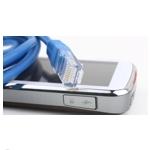 Beginning next quarter, rural network operators may have another option for bringing mobile Internet connectivity to areas that cannot get such connectivity today. That’s when xG Technology plans to begin shipping equipment supporting Internet connectivity, which xG claims can deliver speeds of up to 1.5 Mbps using unlicensed spectrum over a distance as great as four to five miles.
Beginning next quarter, rural network operators may have another option for bringing mobile Internet connectivity to areas that cannot get such connectivity today. That’s when xG Technology plans to begin shipping equipment supporting Internet connectivity, which xG claims can deliver speeds of up to 1.5 Mbps using unlicensed spectrum over a distance as great as four to five miles.
In an interview, xG Technology Vice President of Business Development Chris Whiteley said xG already has eight rural network operator customers committed to using the product, including TelAtlantic Wireless Services, which is affiliated with rural telcos in several Appalachian and Midwest states. Whiteley said cognitive radio technology enables xG’s xMax equipment to automatically configure a range of parameters, simplifying the installation process for companies that may not have a high degree of expertise with deploying wireless networks.
“Installers just have to get the system on poles and the system takes care of itself,” claims Rick Rotondo, xG Technology vice president of marketing, providing a pretty confident view of the implementation of their technology.
As Whiteley explained, the cognitive radio technology of xMax enables it to enhance performance by dynamically moving from one frequency to another within the 902 MHz to 928 MHz band – an unlicensed band that is also used for garage door openers, baby monitors, cordless phones and some video surveillance.
Because of its cognitive capabilities, xMax equipment claims it can be used to meet build-out requirements for carriers that plan to use low-power TV spectrum to deploy two-way radio capability. In addition, some customers plan to use it to support emergency connectivity on a temporary basis as needed to support public safety, Whiteley said.
The xMax line includes wireless access points, xMSC mobie switching centers and xMod personal hotspots. The latter are designed to support smartphones, tablets and laptops with WiFi capability, and can be used to support mobile service if the carrier has deployed sufficient access point infrastructure.
xG previously tested its xMax equipment with Townes Telecommunications in a configuration supporting voice service only, but when equipment becomes available commercially it will support data service as well as voice, Whiteley said.
Network operators using the xG equipment for voice will not assign phone numbers; instead, customers can use a VoIP service such as Skype or Google Voice. If the customer is using a smartphone that supports voice service from another carrier, that capability will continue to work (assuming the carrier has coverage in the area.)
The xMax equipment uses Ethernet backhaul and Whiteley said carriers have a range of options for the physical media, including DSL, coax and microwave.
xG’s product roadmap includes adding the ability for devices to self-configure based on communications with a dynamic cloud based database – an approach already used by Spectrum Bridge and others to support broadband connectivity in vacant TV spectrum known as TV white spaces. Eventually xG also may offer equipment to work in the TV white spaces band but Whiteley said the company is waiting until there is a greater level of certainty about the future of that band.
